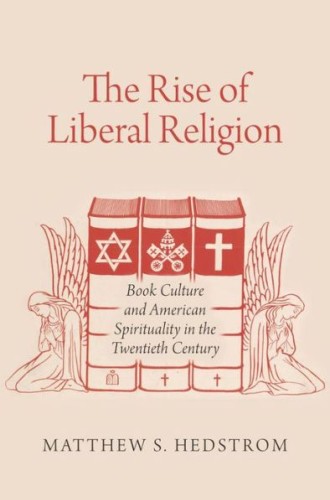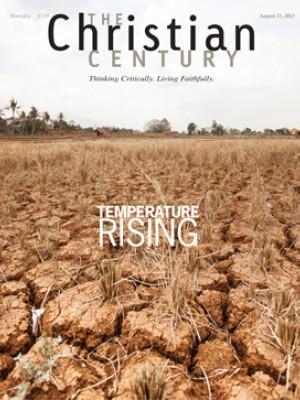Protestant bibliophiles
What we read matters. But what should we read? Matthew Hedstrom describes Protestant angst amid the information overload of the early 20th century, when a profusion of information and new ideas “both frightened and delighted Americans.” Hedstrom asks, “Was America on the verge of a golden age of understanding . . . or more ominously embarking on a path toward cultural chaos?”
He might have been describing our contemporary world of tweets, pins and statuses.
Hedstrom discusses how liberal Protestant ministers sought to shape the nation’s reading habits from the 1920s through the years immediately after World War II. In particular, Protestant leaders and their allies in the worlds of publishing and government sought to persuade “middlebrow” Americans to read more “religious books.” Anxious about the erosion of their cultural influence, they sought new ways to communicate religious ideas.
Read our latest issue or browse back issues.
Luminaries such as Rufus Jones and Harry Emerson Fosdick worked with editors such as Eugene Exman, head of Harper and Brothers’ religious books department, for nearly four decades. The ministers and publishers were optimistic about human nature, believed in human progress despite the horror of two world wars, and insisted that Christians embrace a broad view of religious truth and accept the validity of modern psychology. And they urged Americans to buy and read nonsectarian religious books that would further those values.
Emulating the successful marketing of Reader’s Digest and the Book-of-the-Month Club, a committee of influential Protestant leaders (including Fosdick) established the Religious Book Club in 1927. Each month, a committee endorsed a main selection and an alternative choice. Bookstores and libraries often stocked these titles, and religious periodicals and local congregations passed along the recommendations.
The committee made good on its promise to eschew narrow sectarianism. Over the next several decades, the club recommended titles from Billy Graham, Paul Tillich, C. S. Lewis, Swami Akhilananda and Fulton Sheen. Hedstrom contends that it was precisely because of its openness that the Religious Book Club “remained solidly and consistently a creature of the liberal Protestant establishment.”
The campaigns worked. Sales of religious books rose as a percentage of all books sold during the late 1930s and early 1940s.
In one of the more fascinating parts of Hedstrom’s study, he recounts American leaders’ explicit contention that books had a role to play in defeating fascism. A “war of ideas can no more be won without books,” asserted President Franklin Roosevelt, “than a naval war can be won without ships.” Nazis burned books. Americans, and not just elite Americans, read them. Hedstrom reproduces a fascinating series of wartime posters from various campaigns and committees focused on the promotion of reading. In one poster from the Office of War Information, a Nazi officer plunges a dagger through the Bible. “This is the enemy,” warns the poster.
Leading mainline ministers might have agonized about their lost cultural influence in the 1920s, but by the 1940s it was clear that they still occupied a position near the center of American culture. In the face of Nazism, they fostered religious tolerance and began speaking of the United States as a “Judeo-Christian” society. Though exactly which beliefs or practices Judeo-Christianity entailed remained vague, the wartime effort to “promote Judeo-Christianity,” Hedstrom writes, “became the single greatest force in popularizing the ethos of spiritual cosmopolitanism that had been slowly developing in religious middlebrow culture before the war.”
One might ask whether liberal Protestant leaders were acting against their own self-interest. Indeed, Hedstrom notes, “in meaningful ways the liberal Protestant establishment was turning over the keys to its own castle.” According to contemporary and later critics of the liberal Protestant vision of a “Judeo-Christian America,” Protestant leaders were exchanging historic verities for a desiccated faith stripped of the particularities of any single tradition.
Hedstrom urges readers to reconsider that narrative of mainline decline. By embracing psychology, interfaith alliances and scholarly criticism of the Bible, the liberal Protestant establishment might have turned over the keys to their cultural stewardship of America, but it did so “to fulfill its own highest ideals and aspirations.”
Indeed, Hedstrom argues, the “Judeo-Christian concept . . . gained widespread acceptance because of its ethical and spiritual vitality in addition to its political utility.” Liberal Protestants, in his view, were articulating a faith that was adapted to the challenges of modern life. “What critics have bemoaned as decline,” Hedstrom concludes, “instead constituted a rising force in American religious life.”
On that score, Hedstrom is certainly correct. If Fosdick could have taken stock of the United States nearly a half century after his death, he would have seen traces of his influence. Fosdick’s embrace of psychology in works like On Being a Real Person (1943), his antisectarianism and support for interfaith cooperation, his appreciation for a mystical approach to spirituality, and his emphasis on social justice—all have gained sway not only over mainline Protestants, but over large segments of American society. Especially if we look at American religion beyond the confines of churches, the religious values of Hedstrom’s liberal Protestant leaders have fared well compared to those of their fundamentalist and evangelical counterparts.
Furthermore, one could argue that American society is closer to the ideals of God’s kingdom today than in the middle of the 20th century. Despite Americans’ pining for past golden ages, few serious Christian thinkers would long to return to an era in which most African Americans were segregated and disenfranchised, states criminalized homosexuality and corporations befouled the environment with impunity. Liberal Protestantism might have lost in terms of numbers, but American theology and culture largely moved in the directions it prescribed.
Of course, liberal Protestants have lost much of their cultural clout and are unlikely to ever regain it. Perhaps liberal Protestant leaders should have encouraged their congregants to remain within their ecclesiastical comfort zones a bit more, should have given them more reasons to be Episcopalian or Presbyterian instead of encouraging them to sample Hindu cosmology or read Thomas Merton. Had they done so, however, they would have betrayed their most cherished ideals.
Americans today face a much more diffuse babel of information than their early 20th-century counterparts, and religious leaders still frequently recommend good books and articles, and now blog posts, to their congregants. Hedstrom’s thoughtful and erudite study contains both encouragement and caution for Christians hoping to shape the future social order and its intellectual habits.






